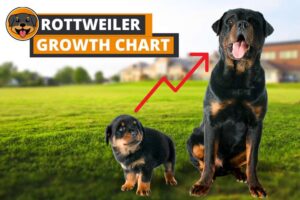I mean, seriously, have you ever seen a tiny Rottweiler puppy and then looked at a full-grown one? It’s amazing how much they grow and change, right?
In this blog post, we’re going to explore how big Rottweilers get.
Rottweiler Size and Growth

Rottweilers are considered a large breed, and their size can vary depending on gender. Let’s take a closer look at the size and growth of both male and female Rottweilers.
Male Rottweilers
Males are typically the larger of the two genders. When they’re fully grown, they stand about 24 to 27 inches tall at the shoulder.
They have a solid, muscular build that gives them their well-known strength and power. When it comes to weight, male Rottweilers can range from 95 to 130 pounds, depending on factors like genetics, diet, and overall health.
Female Rottweilers:
Females are generally a bit smaller than males, but they’re still quite large compared to other dog breeds. Fully grown females usually measure between 22 and 25 inches tall at the shoulder.
They also have a strong, muscular build, but they may appear slightly more slender than their male counterparts.
In terms of weight, you can expect a female Rottweiler to weigh anywhere from 80 to 100 pounds when fully grown.
Growth Patterns
Rottweilers experience most of their growth in the first year or so of their lives. During the puppy stage (0-6 months), you’ll see rapid growth as they quickly gain weight and height.
It’s important to provide them with proper nutrition during this time to support their growth.
As they enter adolescence (6-18 months), their growth rate will slow down a bit, but they’ll still be growing and developing.
During this stage, they’ll also go through some behavioral changes as they mature, so it’s important to continue with consistent training and socialization.
Once a Rottweiler reaches adulthood (18 months onwards), they’ve pretty much reached their full size.
They might still fill out a bit and gain muscle mass, but they won’t be getting much taller. This is when their growth plates, which are the soft areas at the ends of their long bones, will close and harden.
Factors affecting Rottweiler size

There are several things that play a role in determining how big your Rottweiler will get, so let’s take a closer look at each one.
1. Genetics
Genetics plays a big part in determining the size of your Rottweiler. The size of their parents and even grandparents can give you a general idea of how big your pup might get.
If both parents are large, there’s a good chance your Rottweiler will be on the larger side, too. However, sometimes you might see variations in size even within the same litter, so there’s no guarantee.
2. Nutrition
Feeding your Rottweiler a well-balanced, high-quality diet is crucial for their overall growth and development.
Providing the right nutrients and vitamins can help your pup reach their full size potential. Overfeeding, on the other hand, can lead to obesity and other health issues that can negatively impact their growth.
It’s important to consult with your vet to determine the appropriate amount and type of food for your Rottweiler’s age, weight, and activity level.
3. Exercise
Regular exercise is important for a Rottweiler’s overall health and well-being. It helps maintain a healthy weight, build strong muscles, and support proper growth.
However, over-exercising a growing Rottweiler can put too much stress on their joints and bones, potentially leading to growth issues.
It’s essential to find a balance and provide age-appropriate exercise for your pup. As your Rottweiler grows, you can gradually increase the intensity and duration of their exercise routine.
4. Health
A Rottweiler’s overall health can also affect their size. Health issues such as parasites, infections, or hormonal imbalances can hinder their growth.
Additionally, Rottweilers are prone to certain health problems like hip dysplasia and elbow dysplasia, which can impact their mobility and overall size.
Regular vet check-ups and early detection of any health issues can help ensure your Rottweiler grows up strong and healthy.
5. Spaying/Neutering:
Spaying or neutering your Rottweiler can also have an impact on their size. Some studies suggest that spaying or neutering a dog before they reach full maturity can result in slightly taller dogs.
This is because the sex hormones play a role in closing the growth plates. When these hormones are removed through spaying or neutering, the growth plates might close a bit later than usual, allowing the dog to grow a little taller.
However, this is still a subject of debate among experts, and the overall impact on size is generally considered minimal.
Growth Timeline for Rottweilers

Puppy stage (0-6 months)
Rottweiler puppies experience rapid growth during the first six months of their lives. They’ll start out small, but they’ll quickly gain weight and height.
During this stage, it’s important to provide them with a balanced diet that supports their growth and development.
This is also a crucial time for socialization and basic obedience training, which will help shape your Rottweiler’s personality and behavior as they grow up.
Key milestones:
- 8 weeks: Rottweiler puppies can be weaned from their mother and transition to solid food.
- 12-16 weeks: Puppies will have received their initial vaccinations and can start attending puppy classes for socialization and basic training.
- 4-6 months: This is when Rottweiler puppies begin teething, and you might notice them chewing on everything in sight. Provide safe chew toys to help ease their discomfort.
Adolescence (6-18 months)
As your Rottweiler enters adolescence, their growth rate will slow down a bit, but they’ll still be growing and developing both physically and mentally.
Their energy levels will likely be high, and they’ll require consistent training to reinforce good behavior. This is also when you might see some “teenage” rebellion, so patience and persistence are key.
Key milestones:
- 6-12 months: Some Rottweilers may experience a “fear period” during this time, where they become more cautious or anxious. Continue with positive socialization to help them gain confidence.
- 12-18 months: Rottweilers will gradually reach sexual maturity. This is when you might start considering spaying or neutering your dog, but it’s important to consult with your vet about the best timing for your individual dog.
Adulthood (18 months onwards)
Once your Rottweiler reaches around 18 months of age, they’ve likely achieved their full height. They may still fill out a bit more and gain muscle mass, but they won’t be growing much taller.
At this stage, your Rottweiler’s growth plates—the soft areas at the ends of their long bones—will close and harden.
Key milestones
- 2-3 years: Rottweilers are considered fully mature around this age, both physically and mentally. They’ll be more settled in their behavior, but it’s still important to provide regular exercise, mental stimulation, and ongoing training to keep them happy and healthy.
Tips for Ensuring Proper Growth of Rottweiler Puppy

Raising a happy, healthy Rottweiler starts with ensuring they have the proper care and environment to support their growth. Here are some helpful tips to ensure your Rottweiler puppy grows and develops properly:
- Feed a balanced diet: Provide your Rottweiler puppy with high-quality, age-appropriate dog food that meets their nutritional needs. Consult with your vet to determine the best type and amount of food for your puppy’s age, size, and activity level.
- Avoid overfeeding: Overfeeding can lead to obesity and other health issues that can impact your Rottweiler’s growth. Stick to a regular feeding schedule and avoid giving table scraps or too many treats.
- Provide age-appropriate exercise: Regular exercise is essential for your Rottweiler’s overall health and development. Start with gentle exercise for young puppies and gradually increase the intensity and duration as they grow. Be mindful of not over-exercising your growing Rottweiler, as it can put too much stress on their joints and bones.
- Socialize and train early: Start socializing your Rottweiler puppy as early as possible to expose them to a variety of people, animals, and environments. This will help them develop confidence and reduce anxiety as they grow. Begin basic obedience training during the puppy stage to establish good behavior and strengthen your bond.
- Regular vet check-ups: Schedule regular vet visits to monitor your Rottweiler’s growth and overall health. Your vet can provide guidance on proper care, vaccinations, and any potential health concerns that may arise.
- Monitor growth: Keep an eye on your Rottweiler’s growth and development. If you notice any abnormalities or have concerns about their growth rate, consult with your vet for further evaluation.
Final Thoughts
These big, lovable dogs can grow to be quite large, but with the right care and attention, they can become wonderful companions.
Just remember to feed them well, give them plenty of exercise, and keep an eye on their health, and you’ll have a happy, healthy Rottweiler by your side.





